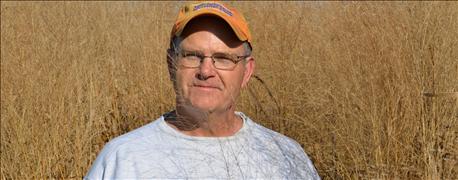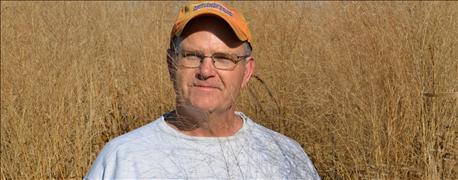
You can find plots of green grass emerging each spring on research farms and at demonstration sites around the country. By late summer, the grasses are several feet tall. Once fall arrives, they turn brown and are ready for harvest. Then they come back to life again next spring.
What are these grasses? What is their purpose? And will farmers ever grow them on the farm?
“Many of them are native warm-season grasses, such as switchgrass and big bluestem,” explains Keith Johnson, a Purdue University Extension forage specialist. “I’ve been working with these grasses as part of a larger project known as CenUSA Bioenergy with other researchers across the country for several years.

RESEARCH CONTINUES: While farmers grow corn and soybeans, Keith Johnson and researchers across the Midwest continue learning more about grasses farmers might grow someday as an energy crop.
The goal is to improve them so that farmers could plant varieties adapted to their climate. They would yield more than standard varieties used on conservation acres in the past. In many cases, they would also be more resistant to diseases which affect these species.”
Biofuel
The goal behind work on these perennial warm-season grasses and other possible biofuel sources is to develop potential crops that farmers could grow and sell as the feedstock for producing energy. Interest in using these types of fuels, and in harvesting and using cornstalks for the same purpose, ramped up several years ago when a growing demand for ethanol brought them into the limelight.
These products can be used to produce ethanol. As ethanol production increased and people debated whether corn grain should be used for food or fuel, many turned their attention to these kinds of crops. Production facilities were just beginning to reach operational stages when the bottom fell out of the energy market. Current low prices for crude oil and ethanol stalled interest in these grasses at the commercial level. But that hasn’t deterred researchers from continuing to develop improved varieties for the future.
“It’s about more than ethanol,” Johnson says. “There is a process called pyrolysis that can extract bio-oil, a crude oil-like product, from high-fiber materials like these grasses that could be used in many ways. Through further processing, the components of bio-oil can be turned into substitutes for fossil fuels currently used for heating, electricity generation and transportation."
Future of biomass?
So will these grasses and other sources of biomass ever make it from plots to farm fields? “I believe that they will,” Johnson says. “The next time there is a major uptick in demand for energy sources and prices rise, there will be interest again.
“Because of what we’re doing now, farmers will ultimately have access to varieties that can be grown economically and produce enough mass per acre to be profitable. We will also better understand the techniques needed to harvest and transport these biofuel feedstocks,” he says.
Bioenergy grasses won’t fit on every farm, Johnson notes. “I see them fitting best on acres like those now in the Conservation Reserve Program. A farmer could establish these crops on marginal acres, have soil protection year-round and still harvest a marketable crop.
“We’re looking down the road, but I believe it will happen.”
About the Author(s)
You May Also Like




